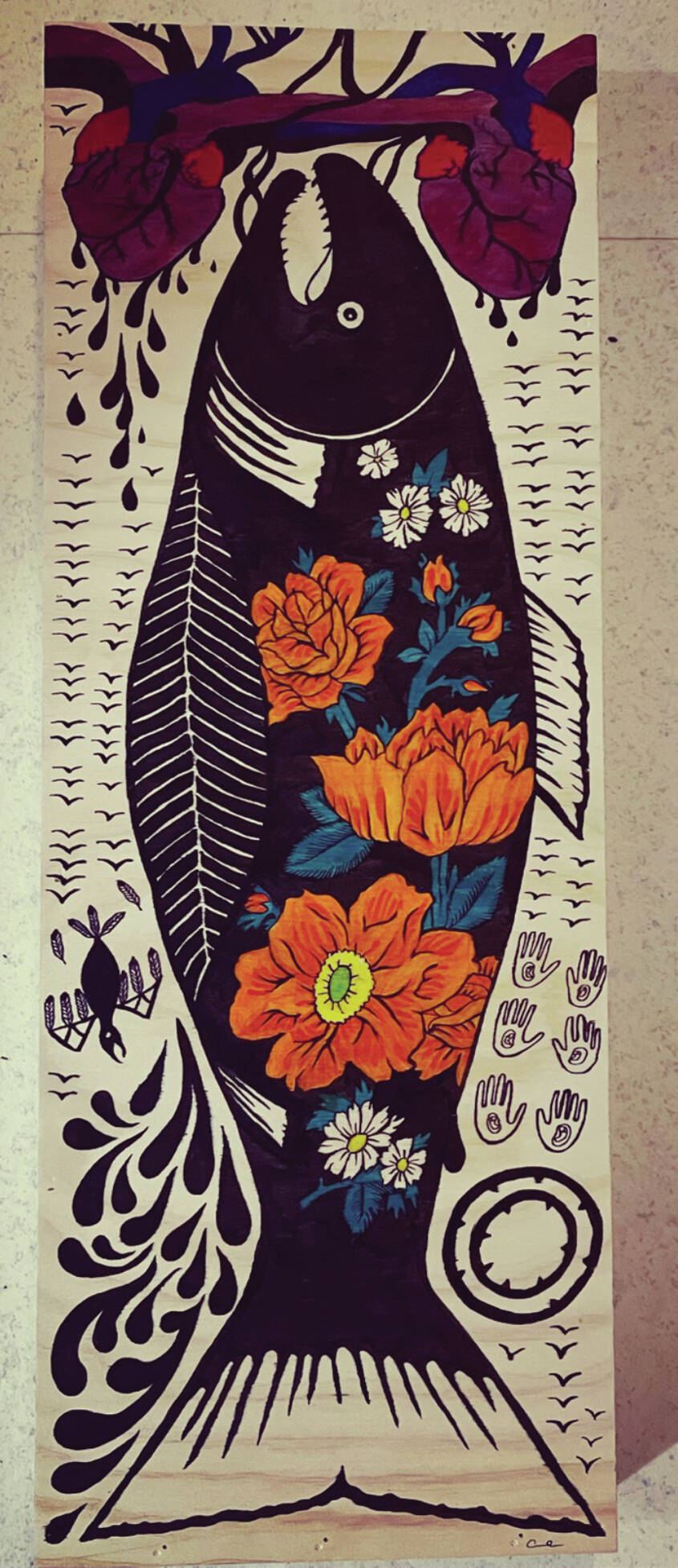Visiting artist Amber Webb started her artist in residence with Bunnell Street Arts Center on Oct. 22. The residence will center around exploring pictorial storytelling, or “storyknifing.”
Originally from Dillingham in western Alaska, Webb uses visual media, including drawing, painting and tattooing, to create symbols that tell stories.
The original Yup’ik name for the community is Curyung, which means “churning waters,” Webb said. The name comes from a story about a monster in the waters of Bristol Bay that stirs up the waters.
In her art, Webb uses the symbol of two circles of teeth to depict the region. It’s a design that she uses frequently.
“It’s two circles with seven teeth, one inside of the other. The symbol was created to honor the story of the seven sisters.
“People say that the seven sisters came down from Aniak on the Kuskokwim. They were starving and they all married white men. That’s where all of the families in Dillingham originated,” Webb explains.
Webb’s definition of storyknifing is something young Yup’ik girls would do to explore and tell stories through the use of symbols.
They would go somewhere outside where the ground was damp and smooth it out to draw symbols and create a storytelling circle. They would take turns smoothing it out and drawing another image.
“I use symbols in my own art work, some of the symbols get translated into clothing. It’s kind of like another form of language or sharing a story through symbol.
“My sister and I used to do it by drawing symbols on each other’s back. Sometimes they were symbols that other people know but sometimes we just made them up. It’s a really simplified way of telling a story but it still has meaning,” Webb said.
The symbol might have a slightly different meaning depending on where you go or who is interpreting it, but the meaning is based on a collective understanding. Webb shared some examples of the symbols she uses frequently: X’s are used to signify trauma or traumatic experiences, V’s or bird shapes signify prayers, the pulhyuk is a fish eye symbol. She refers again to the Bristol Bay seven sisters as a symbol that appears frequently in her work.
“I use symbols in my work when there’s something I want to express but we don’t have a word or structured language for it; it’s a way to visually represent story,” she said.
On Saturday, Oct. 28, Webb will join Quentin Simeon with Spill Your Ink, an evening of exploring tattoo stories. On Wednesday, Nov. 1 she will provide a workshop on storyknife symbols.
At the workshop, Webb said she is hoping to help participants create some of their own personal symbols, if they are interested in exploring that idea.
Storytelling as community understanding
In Dillingham, Webb is employed as a peer recovery support coordinator with the Bristol Bay Area Health Corporation and works with building peer networking in the general region of Bristol Bay. In that role, she organizes wellness gatherings and cultural reclaiming events.
Before arriving in Homer, Webb attended the Elders and Youth Conference, a statewide gathering hosted by the First Alaskans Institute. This year marked the 40th anniversary of the conference. Elders and Youth was followed by the Alaska Federation of Natives Conference and Webb was able to attend that also. One thing she noted at the event this year was an emphasis and presence of pride from Alaska Native youth in their culture and heritage.
“When I was younger, I remember wearing my qaspek around and we didn’t always have that sense of pride. The kids now wear more regalia than we used to. This year at the event there were a lot of people really engaged in the dancing and embracing who they are, their sense of personal identity,” Webb said.
At Elders and Youth, Webb helped moderate a Yup’ik community structure workshop based on the model of Calricaraq, a program hosted by the Yukon Kuskokwim Health Corporation. The program seeks to improve individual and community well-being using the traditional philosophies that have guided Yup’ik life for generations. It has a component of storytelling, also, there is a significance in sharing oral history to create a collective community understanding.
For registration inquiries for the storytelling workshop, email info@bunnellarts.org.


